 Journal of Environmental Monitoring now offers you the chance to publish your accepted article as an Accepted Manuscript. This means that your research is available, in citable form, to the community even more rapidly. Find out more …
Journal of Environmental Monitoring now offers you the chance to publish your accepted article as an Accepted Manuscript. This means that your research is available, in citable form, to the community even more rapidly. Find out more …
JEM now publishing Accepted Manuscripts
PAHs in fog and fingerprinting oil spills on the cover of Issue 11
The hot articles on our cover this month are from Xiang Li and Jiamin Chen (Fudan University) and Zhendi Wang (Environment Canada).
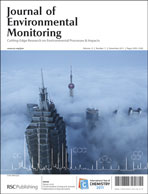 The futuristic image on the outside front cover image highlights the work from Li et al on solid-phase microextraction (SPME) analysis of PAHs in fog. Polluted fog is a serious problem in Shanghai, where the study took place, and this research should provide a basis for better understanding of PAHs in fog-rain events.
The futuristic image on the outside front cover image highlights the work from Li et al on solid-phase microextraction (SPME) analysis of PAHs in fog. Polluted fog is a serious problem in Shanghai, where the study took place, and this research should provide a basis for better understanding of PAHs in fog-rain events.
Characterization of polycyclic aromatic hydrocarbons in fog–rain events
Xiang Li, Pengfei Li, Lili Yan, Jianmin Chen, Tiantao Cheng and Shifen Xu
J. Environ. Monit., 2011, 13, 2988-2993
DOI: 10.1039/C1EM10543D
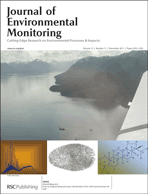 On the inside front cover another serious environmental issue is highlighted – oil spills. Wang et al present a case study of the 2009 Sarnia (Ontario) spill, using GC and GC-MS to characterize the chemical composition and determine the source of the oil spill by identifying oil ‘fingerprints’ through characteristic biomarkers and statistical correlation of target diagnostic ratios.
On the inside front cover another serious environmental issue is highlighted – oil spills. Wang et al present a case study of the 2009 Sarnia (Ontario) spill, using GC and GC-MS to characterize the chemical composition and determine the source of the oil spill by identifying oil ‘fingerprints’ through characteristic biomarkers and statistical correlation of target diagnostic ratios.
Forensic fingerprinting and source identification of the 2009 Sarnia (Ontario) oil spill
Zhendi Wang, C. Yang, Z. Yang, J. Sun, B. Hollebone, C. Brown and M. Landriault
J. Environ. Monit., 2011, 13, 3004-3017
DOI: 10.1039/C1EM10620A
View the rest of Issue 11 including a Focus article on the current state of the art in passive sampling devices
HOT: 2D gas chromatography TOF mass spectrometry to identify organic compounds in aerosols
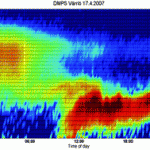 Marja-Liisa Riekkola at the University of Helsinki and coworkers have used a new two-dimensional gas chromatography-time-of-flight mass spectrometry (GCxGC-TOF-MS) method to screen and provide a semi-quantitative analysis of organic compounds in aerosol particles.
Marja-Liisa Riekkola at the University of Helsinki and coworkers have used a new two-dimensional gas chromatography-time-of-flight mass spectrometry (GCxGC-TOF-MS) method to screen and provide a semi-quantitative analysis of organic compounds in aerosol particles.
Analytes in 30 nm, 50 nm and total suspended particles, collected at 3 different timepoints, were identified by comparison to reference libraries and classified by main functional group or element. The classifications allowed the authors to successfully clarify particle composition and determine the influence of particle size on the composition of the different sized particles. They found that the number of compounds increased with increasing particle size, whereas the normalized response factor decreased, aldehydes being the exception.
Comprehensive two-dimensional gas chromatography, a valuable technique for screening and semiquantitation of different chemical compounds in ultrafine 30 nm and 50 nm aerosol particles
José Ruiz-Jiménez, Jevgeni Parshintsev, Totti Laitinen, Kari Hartonen, Marja-Liisa Riekkola, Tuukka Petäjä and Markku Kulmala
DOI: 10.1039/C1EM10486A
This hot paper is currently free to access (following a simple registration for individual users), so why not take a look if aerosols and atmospheric chemistry are your area?
Top ten most accessed articles in September
This month sees the following articles in the Journal of Environmental Monitoring that are in the top ten most accessed:
The release of engineered nanomaterials to the environment
Fadri Gottschalk and Bernd Nowack
J. Environ. Monit., 2011, 13, 1145-1155
DOI: 10.1039/C0EM00547A
Elevated antimony concentrations in commercial juices
Claus Hansen, Alexandra Tsirigotaki, Søren Alex Bak, Spiros A. Pergantis, Stefan Stürup, Bente Gammelgaard and Helle Rüsz Hansen
J. Environ. Monit., 2010, 12, 822-824
DOI: 10.1039/B926551A
The antibacterial effects of engineered nanomaterials: implications for wastewater treatment plants
Ndeke Musee, Melusi Thwala and Nomakhwezi Nota
J. Environ. Monit., 2011, 13, 1164-1183
DOI: 10.1039/C1EM10023H
A comparison of rapid and conventional measures of indicator bacteria as predictors of waterborne protozoan pathogen presence and density
Samuel Dorevitch, Mary Doi, Fu-Chih Hsu, King-Teh Lin, Jennifer D. Roberts, Li C. Liu, Ross Gladding, Ember Vannoy, Hong Li, Margit Javor and Peter A. Scheff
J. Environ. Monit., 2011, 13, 2427-2435
DOI: 10.1039/C1EM10379B
Science and strategies to reduce mercury risks: a critical review
Noelle E. Selin
J. Environ. Monit., 2011, 13, 2389-2399
DOI: 10.1039/C1EM10448A
Improvement of the BCR three step sequential extraction procedure prior to the certification of new sediment and soil reference materials
G. Rauret, J. F. López-Sánchez, A. Sahuquillo, R. Rubio, C. Davidson, A. Ure and Ph. Quevauviller
J. Environ. Monit., 1999, 1, 57-61
DOI: 10.1039/A807854H
Catalytic hydrodechlorination of 1,2-dichloroethane using copper nanoparticles under reduction conditions of sodium borohydride
Chang-Chieh Huang, Shang-Lien Lo, Shin-Mu Tsai and Hsing-Lung Lien
J. Environ. Monit., 2011, 13, 2406-2412
DOI: 10.1039/C1EM10370A
Exposure assessment for methyl and total mercury from seafood consumption in Korea, 2005 to 2008
Hyo-Bang Moon, Sang-Jo Kim, Hyejin Park, Yun Sun Jung, Suuggyu Lee, Yun-Hee Kim and Minkyu Choi
J. Environ. Monit., 2011, 13, 2400-2405
DOI: 10.1039/C1EM10504C
Whole-cell bacterial biosensors for rapid and effective monitoring of heavy metals and inorganic pollutants in wastewater
Ademola O. Olaniran, Lettisha Hiralal and Balakrishna Pillay
J. Environ. Monit., 2011, 13, 2914-2920
DOI: 10.1039/C1EM10032G
Assessment of the effects of Cr, Cu, Ni and Pb soil contamination by ecotoxicological tests
Giulia Maisto, Sonia Manzo, Flavia De Nicola, Rita Carotenuto, Annamaria Rocco and Anna Alfani
J. Environ. Monit., 2011, Advance Article
DOI: 10.1039/C1EM10496A
Why not take a look at the articles today and blog your thoughts and comments below.
Fancy submitting an article to the Journal of Environmental Monitoring? Then why not submit to us today or alternatively email us your suggestions.
Hot article: Exposure of workers in aluminium smelters to beryllium
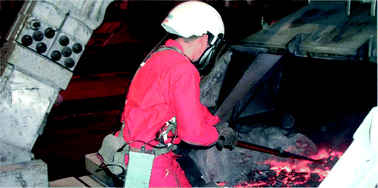 Data published in recent years has raised concern that the current occupational exposure limits (OELs) may not be low enough to protect workers from the toxic effects of exposure to beryllium. Beryllium is present in aluminium ores, and therefore workers in the primary production process of aluminium may be at risk from exposure, even at low levels, to Be.
Data published in recent years has raised concern that the current occupational exposure limits (OELs) may not be low enough to protect workers from the toxic effects of exposure to beryllium. Beryllium is present in aluminium ores, and therefore workers in the primary production process of aluminium may be at risk from exposure, even at low levels, to Be.
Yngvar Thomassen and coworkers have investigated the exposure of workers across 7 Norwegian aluminium smelters, collecting a total of 480 samples across two sampling campaigns. Water soluble Be, Al, F– and Na inhalable, thoracic and respirable aerosol fractions were determined, providing information on the amount and composition of the particulate matter which will be useful in better understanding the potential risks of occupational Be exposure.
Download the full article to read the authors discussion of their results and potential implications – this hot article is currently free to access for 4 weeks:
Occupational exposure to beryllium in primary aluminium production
Nils Petter Skaugset, Dag G. Ellingsen, Kari Dahl, Ivar Martinsen, Lars Jordbekken, Per Arne Drabløs and Yngvar Thomassen
J. Environ. Monit., 2012, Advance Article
DOI: 10.1039/C1EM10539F
This article is part of our forthcoming collection from the AIRMON 2011 conference, the 7th International Symposium on Modern Principles for Air Monitoring and Biomonitoring held on June 19–23 this year in Loen, Norway. Check back soon for more hot articles in the collection.
On the cover: mapping mercury in snow
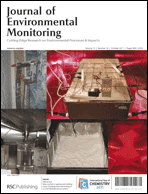 On the cover of Issue 10 is Frank Wania’s hot article on mapping the fate of mercury in artificial snow, under carefully controlled laboratory conditions.
On the cover of Issue 10 is Frank Wania’s hot article on mapping the fate of mercury in artificial snow, under carefully controlled laboratory conditions.
Mercury fate in ageing and melting snow: Development and testing of a controlled laboratory system
Erin Mann, Torsten Meyer, Carl P. J. Mitchell and Frank Wania
The issue also contains the regular item from Mike Sharpe on the latest news from industry, legislation and the literature, and news from China from our Associate Editor, Liang-Hong Guo.
The role of ‘Big Society’ in monitoring the state of the natural environment
 In a time of cuts to science funding, Colin Mackechnie and colleagues at the Centre for Ecology & Hydrology, UK, look at the role that volunteers can play in environmental monitoring.
In a time of cuts to science funding, Colin Mackechnie and colleagues at the Centre for Ecology & Hydrology, UK, look at the role that volunteers can play in environmental monitoring.
They review available literature on the use of ‘citizen science’ for environmental monitoring and highlight important issues surrounding the use of volunteers – such as limited technical expertise or access to equipment, incomplete monitoring due to geographical restraints or lack of interest in certain areas of science and difficulties coordinating and exchanging information.
It’s not all doom and gloom though – the authors also give examples of successful volunteer monitoring work and conclude that ‘the current engagement of volunteers in UK monitoring provides valuable data’.
Interested? Why not take a look on a interesting community solution to the big funding problem:
The role of ‘Big Society’ in monitoring the state of the natural environment
Colin Mackechnie, Lindsay Maskell, Lisa Norton and David Roy
J. Environ. Monit., 2011, 13, 2687-2691
DOI: 10.1039/C1EM10615E
HOT: Quality controlled snow – a highly controlled experimental system for studying the fate of mercury in snow
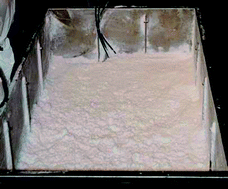 The Environment is a messy, disordered, inherently inhomogeneous place hardly conducive to conducting precise scientific studies. Which is unfortunate when we need to know detailed information about how chemicals interact with our surroundings. Mercury is a good example, a serious pollutant, but it has so many possible reactions in the environment that studying field samples can give even the most methodical researcher a headache.
The Environment is a messy, disordered, inherently inhomogeneous place hardly conducive to conducting precise scientific studies. Which is unfortunate when we need to know detailed information about how chemicals interact with our surroundings. Mercury is a good example, a serious pollutant, but it has so many possible reactions in the environment that studying field samples can give even the most methodical researcher a headache.
In this hot paper Frank Wania et al. at the University of Toronto have sort to reduce the chaos by creating a highly controlled experimental system for studying the fate of mercury in snow. They create, age and melt snow contaminated with mercury and with a variety of compositions to allow a detailed mechanistic study of the fate of the pollutant.
Read their detailed study, which includes a candid discussion of its potential and limitations, here. It’s free to access for the next 4 weeks:
Mercury fate in ageing and melting snow: Development and testing of a controlled laboratory system
Erin Mann, Torsten Meyer, Carl P. J. Mitchell and Frank Wania
J. Environ. Monit., 2011, Advance Article
DOI: 10.1039/C1EM10297D
Top ten most accessed articles in August
This month sees the following articles in the Journal of Environmental Monitoring that are in the top ten most accessed:
The antibacterial effects of engineered nanomaterials: implications for wastewater treatment plants
Ndeke Musee, Melusi Thwala and Nomakhwezi Nota
J. Environ. Monit., 2011, 13, 1164-1183
DOI: 10.1039/C1EM10023H
The release of engineered nanomaterials to the environment
Fadri Gottschalk and Bernd Nowack
J. Environ. Monit., 2011, 13, 1145-1155
DOI: 10.1039/C0EM00547A
The devil is in the details (or the surface): impact of surface structure and surface energetics on understanding the behavior of nanomaterials in the environment
Imali A. Mudunkotuwa and Vicki H. Grassian
J. Environ. Monit., 2011, 13, 1135-1144
DOI: 10.1039/C1EM00002K
Origin, separation and identification of environmental nanoparticles: a review
Tsung M. Tsao, Yue M. Chen and Ming K. Wang
J. Environ. Monit., 2011, 13, 1156-1163
DOI: 10.1039/C1EM10013K
Validation of the inhalable dust algorithm of the Advanced REACH Tool using a dataset from the pharmaceutical industry
Patricia E. Mc Donnell, Jody M. Schinkel, Marie A. Coggins, Wouter Fransman, Hans Kromhout, John W. Cherrie and Erik L. Tielemans
J. Environ. Monit., 2011, 13, 1597-1606
DOI: 10.1039/C1EM10189G
Elevated antimony concentrations in commercial juices
Claus Hansen, Alexandra Tsirigotaki, Søren Alex Bak, Spiros A. Pergantis, Stefan Stürup, Bente Gammelgaard and Helle Rüsz Hansen
J. Environ. Monit., 2010, 12, 822-824
DOI: 10.1039/B926551A
Changes in maternal blood concentrations of selected essential and toxic elements during and after pregnancy
Solrunn Hansen, Evert Nieboer, Torkjel M. Sandanger, Tom Wilsgaard, Yngvar Thomassen, Anna Sofia Veyhe and Jon Øyvind Odland
J. Environ. Monit., 2011, 13, 2143-2152
DOI: 10.1039/C1EM10051C
Improvement of the BCR three step sequential extraction procedure prior to the certification of new sediment and soil reference materials
G. Rauret, J. F. López-Sánchez, A. Sahuquillo, R. Rubio, C. Davidson, A. Ure and Ph. Quevauviller
J. Environ. Monit., 1999, 1, 57-61
DOI: 10.1039/A807854H
Global climate change and contaminants—an overview of opportunities and priorities for modelling the potential implications for long-term human exposure to organic compounds in the Arctic
James M. Armitage, Cristina L. Quinn and Frank Wania
J. Environ. Monit., 2011, 13, 1532-1546
DOI: 10.1039/C1EM10131E
Distribution, accumulation and mobility of mercury in superficial sediment samples from Tianjin, northern China
Guanghong Wu, Zheng Wei and Ruixian Su
J. Environ. Monit., 2011, 13, 2488-2495
DOI: 10.1039/C1EM10365B
Why not take a look at the articles today and blog your thoughts and comments below.
Fancy submitting an article to the Journal of Environmental Monitoring? Then why not submit to us today or alternatively email us your suggestions.
HOT: analysing roadway runoff – the micron problem
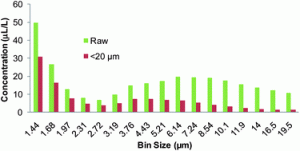 Determining the particle size distribution and particle fractionation of particles in roadway runoff is important as they carry potent organic and inorganic pollutants. To date however, no standardised, accurate method exists for analysing the micron-sized particles.
Determining the particle size distribution and particle fractionation of particles in roadway runoff is important as they carry potent organic and inorganic pollutants. To date however, no standardised, accurate method exists for analysing the micron-sized particles.
In this HOT paper Masoud Kayhanian and Brandon Givens from the University of California have compared the ability of filter paper and sieving filtration methods to determine PSDs and concentrations, finding that the commonly used method (paper filtration) is anything but accurate.
Read their full assessment of the level of inaccuracy of paper filtration here – the article is free to access for 4 weeks:
Processing and analysis of roadway runoff micro (< 20 μm) particles
Masoud Kayhanian and Brandon Givens
J. Environ. Monit., 2011, Advance Article
DOI: 10.1039/C1EM10375J










